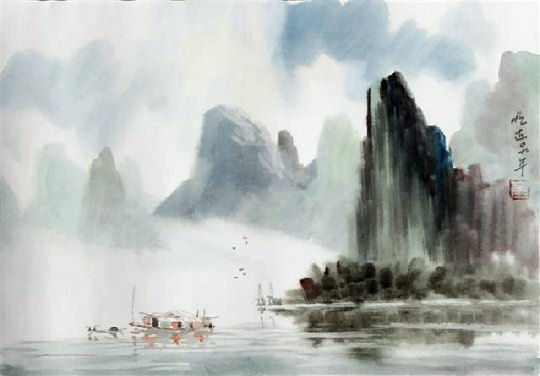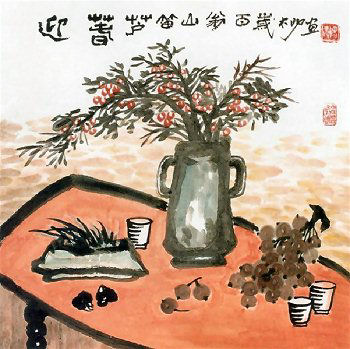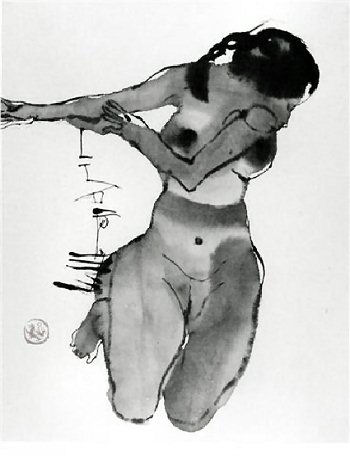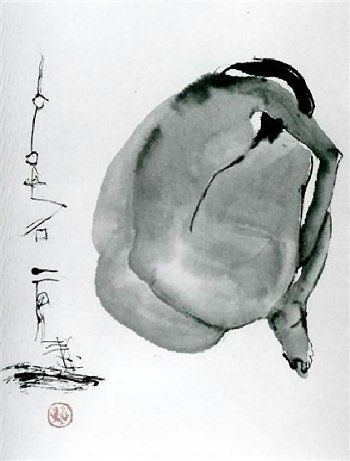![]()
Contemporary Chinese ink
and watercolour paintings
- the influence from the western traditions
This text discusses four Chinese watercolour painters, and how they in different ways base their expression and personal style on a fundament of traditional Chinese paintings mixed with some western influence.
Traditional Chinese paintings are always painted with ink on silk or rice paper. Although water is part of the process, those paintings are not considered to be watercolours in China, and watercolours based on pigments with different colours have first been introduced in China in the beginning of the 20th century.
It is possible to divide traditional Chinese paintings in three groups, namely: Fine brush, Free hand and Heavy colour. Fine brush is typical of the period before the Song dynasty. They were often painted on silk, and they showed people with influence in the society. The painting of ladies by Zhou Fang is typical of the fine brush style with the detailed expressions in for example the faces and it is one of the most famous and earliest known paintings in China.

Painting by Zhou Fang made on silk.
Heavy colour is a technique often used by painters working with motives of the minorities.
Free hand paintings are what we often in the western world consider as traditional Chinese paintings. The tradition started with the painting of for example Wu Ynan Zhi. They show the nature, and they express a movement towards making the art both for, and about, the people.

Painting by Wu Ynan Zhi in the typical free
hand style.
The many stamps represent not only the painter,
but also different owners during the lifetime of this painting.
A traditional Chinese painting of the nature will often show mountains and water. The Chinese people view a mountain as the symbol of longevity, and water as the symbol of wealth. There are many white areas in the paintings, and mountains, for example, are often not defined in there lower part. They consider the elements in nature to show three surfaces, a left, a right and a top surface. Therefore you will see everything a little from above. The paintings do not show the landscape from a single point, as it is the case with the rules of perspective we use, but the paintings rather show the memories of a landscape, and they can therefore be an integration of the landscape in many directions. Also it is not a depiction of the landscape elements in details but more a number of symbols placed together. If the format is vertical, then the perspective is achieved by making the nearest elements in the bottom, and the furthest elements in the top.
Paintings of nature will often show some people, just to remind you about mankind’s dependence on nature. It should also be mentioned that the message in a Chinese painting is clearly outspoken, as for example: harmony, love, care and fight. In western paintings we prefer to show an open question, so the viewer can make his or her own interpretation.
Other popular free hand paintings show flowers, fruits, fish and birds.
For hundred of years the Chinese paintings have by tradition been refined without much change in style, process and content. In the beginning of the 20th century China opened itself towards the western world. A number of Chinese painters moved to Europe, especially France, where they were influenced by western art, technique and culture. They partly introduced the watercolour technique into the Chinese paintings, which up to that time were based on ink and rice paper, and the artists also got new and different inspirations from the western culture.
Four Chinese painters
To discuss the influence of western tradition on Chinese painters we will look at four painters: Cui Mingda, Yang Tai Yang, Zong Qi-xiang and Shi Hu.
Cui Mingda is born in Guilin in 1952 and he graduated from the painting department of Guangxi Art College in 1977. While I visited him in Guilin, he made two paintings, a traditional Chinese painting and a western influenced painting to illustrate the difference. The traditional painting is made on rice paper with ink. The paper is used dry, and the misty value is obtained by letting a mixture of ink and water flow from a slowly moving brush (the rice paper is so absorbing, that it continues to absorb ink as long as the brush touches the paper). The vitality of the two fish in the painting is very important because this expression of vitality turns the large white area into a lake. A painting like this is often made by using only one brush for the whole painting process. The large grey areas are made with the side of the brush in a mixture of ink and water, and the black areas in the foreground with the tip of the brush in pure ink. The painting is a typical free hand ink painting.

Chinese ink painting by Cui Mingda. 34 cm ×
28 cm. 2009
Cui Mingda’s western influenced painting is a pure watercolour painting made on Chinese manufactured paper ( ~200 g/m2). The whole paper is made wet with brush and clean water and mounted at an angle of 60o. He starts at once to paint the sky and the mountains in the background to get the spirit of “misty Guilin”. Most of the painting is done while the paper is humid. Only the boat and other small details are made at a late stage when the paper is almost dry. The painting is not particularly western in style, but Cui Mingda argues that a traditional Chinese painting will show outline of the mountains, and especially the mountain in the middle with indication of a form would be impossible to make in an ink drawing, because the form is obtained by removing colour with a clean damped brush. He made both his paintings in a studio by imagination which is typical of traditionally Chinese paintings, so they are more an expression of the elements they are showing than a true depiction of the scenes. The signature on the right side of the paintings shows the artist’s given name and the year in which it is painted, and the stamp shows the family name.

Chinese water colour painting by Cui Mingda.
39 cm × 28 cm. 2009
Yang Tai Yang is born in Guilin, and after his education he moved to France for some years, but now he is living in Guilin again where he is president of Guilin Chinese Painting Academy. He paints in a personal style which is a mixture Chinese and western style. The painting of the table is made on paper with ink and Chinese painting pigments. It has the traditional Chinese calligraphy and stamps, but most of the surface is covered by colour, which is typical of western style. Furthermore, it shows the “three side” painting of the objects, which is obvious in this case.

Painting by Yang Tai Yang. 68 cm × 68 cm.
Zong Qi-xiang was born in Nangjing in 1917, and graduated from Art Department of Central University in 1944. Some of his paintings show a further logical development of the traditional Chinese paintings. His picture with a night scene has a strong use of ink on paper, and the whole paper is covered, but the scene is a traditional Chinese landscape with mountains, water and trace of people’s activity.

Ink painting by Zong Qi-xiang
The last Chinese contemporary painter to be presented is Shi Hu. Shi Hu is born in Xushui, Hebei Province, China in 1942. He attended Beijing Art and Crafts School and Zhejiang Fine Arts Institute. Shi Hu paints, among other things, on rice paper with ink. This is a traditional Chinese way of painting, but compared to themes as flowers, animals e.g. he chooses a very untraditional object, namely the nude body of a person. His paintings show a marvellous brushwork and they are formed with a very high level of sensitivity and energy. His calligraphy is also very strong and expresses a sharp energy rather than a traditional harmony. The paintings are fast snapshots, because we have to remember that it is almost impossible to make any change in an ink drawing on rice paper. Like many other Chinese paintings, the nudes are made without model and they are therefore an expression of the woman in general.

Ink painting by Shi Hu. Nude 7, 43 cm × 56
cm, 2000.

Ink painting by Shi Hu. Nude 14, 43 cm × 56
cm, 2000.
Guilin Art Museum
This article is partly based on visits to Guilin Art Museum. Guilin Art Museum is both a Museum and also an art school where local professors and artists are teaching a number of students, 60 – 100 students, as well as a number of children in the weekend. The museum has a gallery for sale of works made by the teachers. Peter Fang from the art school has been interviewed for this article, and he has also been an interpreter in the painting session with Cui Mingda.
Guilin art museum: www.glartmus.com